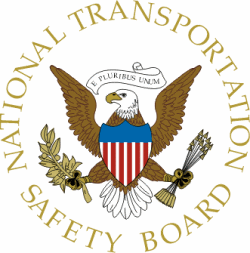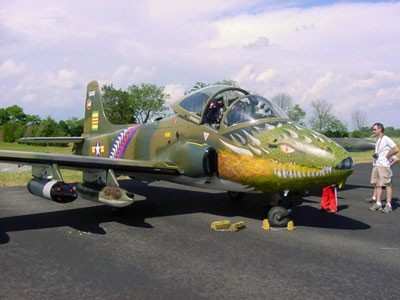Lost Control During A Low-Altitude Maneuver Which Resulted In
The Crash
In its probable cause report from an accident in which a BAC
Strikemaster went down last February in the Hudson River, the NTSB
found that the pilot simply did not maintain control of the
airplane, in part due to his unfamiliarity with its operation. The
takeaway here may be that a type rating for an aircraft is not
necessarily a license to push beyond your personal limits.

NTSB Identification: ERA11FA165
14 CFR Part 91: General Aviation
Accident occurred Saturday, February 26, 2011 in Kingston, NY
Probable Cause Approval Date: 12/27/2011
Aircraft: BRITISH AIRCRAFT CORP BAC 167 STRIKEMASTER, registration:
N167SM
Injuries: 1 Fatal.
According to witnesses and corroborated by a video, the pilot
performed a rolling maneuver over the runway before returning for a
second pass of the runway at an airport that he told his friends he
would be flying over. The second pass was flown at a low altitude
with the gear retracted. Following the low pass, the pilot abruptly
pitched the nose up and entered a steep left turn. The nose of the
airplane dropped, and the airplane entered a descending spiral and
crashed into a river. The sound of the engine was heard
continuously on the video of the flight until the airplane crashed.
An examination of the wreckage did not reveal any evidence of a
preimpact mechanical malfunction or failure with the airplane that
would have precluded normal operation. The pilot had logged about
21 hours in the airplane and had obtained a type rating in the
airplane about 2 1/2 months prior to the accident. His training in
the airplane make and model included aerobatic maneuvers, stalls,
and recovery from unusual attitudes. The airplane’s owner was
not aware that the pilot was planning to perform aerobatic
maneuvers and further stated that he would never have approved the
pilot to perform solo aerobatics in his airplane.
The National Transportation Safety Board determines the probable
cause(s) of this accident to be the pilot’s failure to
maintain airplane control while maneuvering. Contributing to the
accident was the pilot's lack of experience in the accident
airplane.
The British Aircraft Corporation BAC 167 Strikemaster, N167SM,
crashed into the Hudson River following an in-flight loss of
airplane control near Kingston, New York. The experimental airplane
was registered to and operated by Dragon Aviation Inc. under the
provisions of 14 Code of Federal Regulations Part 91 as a
positioning flight. Visual meteorological conditions prevailed and
an instrument flight rules (IFR) flight plan was filed. The private
pilot was killed. The flight originated at John Murtha
Johnstown-Cambria County Airport, Johnstown, Pennsylvania, about
1235.
According to a representative for Dragon Aviation, the pilot was
flying the airplane to Columbia County Airport (1B1), Hudson, New
York, with his permission. The purpose of the flight was to
reposition the airplane from Smyrna, Tennessee to Hudson. A fuel
stop at Johnstown was planned.
While at Johnstown, the pilot purchased fuel and telephoned
friends to inform them that he would be flying over Kingston-Ulster
Airport (20N), near Kingston. After calling his position on the
airport Unicom frequency, he reportedly flew over the airfield and
performed a rolling maneuver, described by witnesses as a roll or a
barrel roll. Following the rolling maneuver, the airplane remained
in the traffic pattern and the pilot executed a second pass, down
the centerline of runway 15 at low altitude and with the landing
gear retracted. Following the low pass, the pilot reportedly pulled
the airplane up to a nose-high attitude and initiated a left-hand
turn. During the turn, the airplane nose reportedly dropped and the
airplane entered a descending turn until it impacted the river.
A friend of the pilot was on the ramp at 20N and videotaped the
airplane in flight. A copy of the video was provided to
investigators. A review of the video revealed that the airplane
overflew the runway at low altitude, with the landing gear
retracted. The airplane then pitched up and entered a steep,
left-hand bank. The nose of the airplane then dropped and the
airplane entered a descending spiral until it disappeared below the
horizon. The sound of a turbine engine was heard until the sound of
an impact was heard.
PERSONNEL INFORMATION
The pilot held a private pilot certificate with airplane single
engine, multi-engine, and instrument airplane privileges. He
received a type rating in the BAC 167 on December 12, 2010. The
temporary airman certificate for his BAC 167 type rating included
the following restriction: VFR (visual flight rules) Only. An
examination of the pilot’s logbook revealed that he had
logged about 1,187 hours total time, including 20.6 hours in the
BAC 167.
The pilot’s family provided training records that
documented 12 flights that occurred in the BAC 167 between June 5,
2010 and November 13, 2010. According to the records, the pilot
performed loops, barrel rolls, split-s maneuvers, and Cuban eights.
He achieved a proficient grade with the loop, barrel roll, and
split-s. He also received proficient grades in airwork, including
stalls, flight at slow speed, steep turns, and recovery from
unusual attitudes.
BAC Strikemaster 'Dragon'

AIRCRAFT INFORMATION
The airplane was a single-engine attack jet, manufactured in
1969. The airplane was equipped with a Rolls Royce Viper 535
turbojet engine.
An examination of the airplane maintenance records indicated
that an approved inspection program inspection was performed on
February 18, 2011, at Smyrna Air Center, Smyrna, Tennessee at an
airplane and engine total time of 3502.8 hours.
METEOROLOGICAL INFORMATION
The 1353 weather observation for Poughkeepsie, New York, (POU),
located about 21 miles south of 20N, included the following:
surface winds from 250 degrees at 7 knots, clouds broken at 10,000
feet, visibility 10 statute miles, temperature 2 degrees Celsius,
dew point minus 10 degrees Celsius, and altimeter setting of 30.02
inches of mercury.
WRECKAGE AND IMPACT INFORMATION
The wreckage was located in the Hudson River, in ice-covered,
shallow water, at approximate coordinates of 41 deg 58.85N, 073 deg
56.820W. After recovery from the river, the wreckage was moved to a
shipyard in Kingston where an examination was performed on February
28, 2011. The examination did not reveal evidence of a preexisting
mechanical malfunction or failure. All major structural components
of the airplane were located and identified. The main wreckage
consisted of the forward fuselage, cockpit, engine, and a majority
of the left wing. All internal wing, wing tip, and under wing drop
fuel tanks were breached. The engine remained attached to the
fuselage. The single-stage turbine was found partially protruding
from the engine case; the turbine blades were still attached to the
disk and all visible blades were bent opposite the direction of
rotation. All three landing gear were found in the retracted
position.
The cockpit and forward fuselage were crushed in a forward
direction. The ejection seats were separated from the cockpit, and
were held together by stainless steel tubing. The ejection seat
rocket motors were intentionally inert. The nose gear was observed
inside the wheel well. Several cockpit instruments were found loose
in the wreckage, separated from their instrument panel locations.
The airspeed indicator registered about 170 knots. The engine
revolutions per minute indicator registered about 57 percent. The
engine temperature indicator registered about 505 degrees C. The
thrust lever was broken from its mount, and the lever arm bent at a
reduced (aft) thrust position.
The right wing was separated at the wing root. The right flap
was separated from the inboard wing section. The right, main
landing gear remained inside the wheel well. The right aileron was
separated from the wing and was buckled on each end. The tip, drop,
and internal bladder fuel tanks were breached. All observed
connections to the flap and aileron exhibited overload
failures.
The majority of the left wing remained attached to the forward
fuselage/cockpit/engine section by cables. The spar was separated
at the wing root. The left flap was separated from the inboard wing
section and was in a single piece. The center of left flap was bent
upwards, and there was leading edge crushing and skin buckling on
the flap surface. The left, main landing gear remained inside the
wing wheel well. The left aileron remained attached to the aft,
outboard wing section, was bent, crushed, and exhibited 45-degree
buckling on the upper skin surfaces. The tip, drop, and internal
bladder fuel tanks were breached. All observed connections to the
flap and aileron exhibited overload failures.
The left and right horizontal stabilizers remained attached to
each other, integral with the stainless steel engine exhaust
cone.
The left horizontal stabilizer leading edge was crushed aft and
up throughout its length. The left elevator had minor impact
damage. The left elevator trim tab was found positioned
approximately 10 degrees tab down. The trim actuator rod remained
attached and was not bent.
The inboard section of the right horizontal stabilizer leading
edge was crushed aft and up along half of its length. The outboard
leading edge exhibited minor impact damage. The right elevator trim
tab was found positioned approximately 10 degrees tab down. There
was downward bending on the trailing edge of the right
elevator.
The vertical stabilizer was separated from the empennage and was
crushed aft throughout its length. The stabilizer was bowed to the
right, as viewed from aft. The rudder was separated from the
vertical stabilizer. The rudder exhibited minor impact damage,
which was more pronounced at the upper end. The rudder trim tab was
displaced about 30 degrees tab left. There was leading edge
crushing, which was more pronounced at the lower end.
 Affordable Flying Expo Announces Industry MOSAIC Town Hall
Affordable Flying Expo Announces Industry MOSAIC Town Hall Classic Aero-TV: Composite-FX Sets Elevates the Personal Helicopter Market
Classic Aero-TV: Composite-FX Sets Elevates the Personal Helicopter Market Aero-News: Quote of the Day (10.25.25)
Aero-News: Quote of the Day (10.25.25) ANN's Daily Aero-Term (10.25.25): Ground Stop (GS)
ANN's Daily Aero-Term (10.25.25): Ground Stop (GS) NTSB Final Report: Gallow Daniel A Kitfox Classic IV
NTSB Final Report: Gallow Daniel A Kitfox Classic IV




